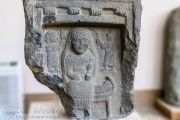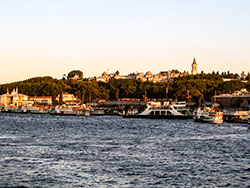Antakya, or Hatay as its official name is, is a prosperous and charming city near the Syrian border divided in two by the river Orontes or Asi, as it is called nowadays. On the west bank there is the modern city with its wide boulevards and on the east bank is the scenic old Arabic town with its small alleys. Most people visit Antakya for its Hatay Archeology Museum with its world-famous collection of Roman mosaics.
History of Antakya
Antakya was founded in 300 BCE on the banks of the river Orontes (present Asi) as Antioch-ad-Orontes by Seleucus Nicator one of Alexander's generals. The city grew quickly to half a million people and, under the Romans, became one of the centres of Christianity. Saint Peter spent some time in Antioch between 47-54 AD and, together with St. Paul and St. Barnabas, founded one of the world's first Christian communities. Antakya was also the starting point for the first of St. Paul's travels in Anatolia in 47-49 AD. The city survived a massive earthquake in the 5th century killing 250,000 people and was later fought over by Persians, Byzantines, Arabs, Armenians, Seljuks, Crusaders, and Mamluks. The latter literally wiped out the city and it never regained its former glory.
After the first World War, Antakya was part of the French protectorate of Syria until 1939 when it became independent as the Republic of Hatay (capital city Iskenderun aka Alexandretta). After a short period, Hatay joined the Republic of Turkey on 23 July 1939.
Sights & Photos
The relatively large number of churches still bear testimony of Antakya's importance to Christianity. The most important church is the tiny Cave-Church of Saint Peter(Sen Piyer Kilisesi) which is generally considered as the world's first Christian church and is located up a hill, about 2-3 km from Antakya's centre. In 1983, the Church of St. Peter was declared a Holy Site by the Vatican. It was also in ancient Antioch that the saints gave their new religion the name Christianity. Antakya remains the titular seat of five Christian patriarchs and there still live some 1200 Christians in Antakya. The majority, some 250 families, are Orthodox and worship in the St. Paul Greek Orthodox Church. This fine building was rebuilt with Russian assistance in the 19th century after a devastating earthquake destroyed its predecessor. The church contains some beautiful icons. The Protestant church was established in 2000 by a Korean Methodist mission and is housed in a former French Consular building. As a symbol of religious tolerance, Antakya's Catholic church is next door the Sermaye Camii (Sermaye mosque). The beautiful ornate şerefe (balcony) on the minaret of the Sermaye Camii is depicted on most tourism posters of Antakya. The Habibi Neccar Camii dates from 636 AD and is known as the first constructed mosque of Antakya. After being damaged by an earthquake, it was reconstructed during the Ottoman period in the 17th century, but the minaret kept its former appearance.
Here are the photos of Antakya, click on the thumbnails to get a greater picture.
https://turkeyphotoguide.com/antakya#sigProIdbe02c20487
The main reason to visit Antakya is for its excellent Hatay Archeological Museum (Hatay Arkeoloji Müzesi) whose collection of well-preserved Roman mosaics ranks among the best of the world. Most of the mosaics have been unearthed at the suburb of Daphne, present-day Harbiye, a main Roman holiday resort. The mosaics are well laid out in four rooms of the museum. Most of them depict scenes from Greco-Roman mythology.
The pictures that are shown here date from our visits in 2004 and 2013. In 2014, the museum moved to a new location and contains now the world's largest display area for mosaics.
Travel Information & Travel Tips
The blending of Turkish, Arabic and French flavours has resulted in the high-quality cuisine for which Antakya is known. Hummus is served here on a regular basis, while this meal is rarely found in the rest of Turkey. We had a very tasteful dinner in Antakya Evi (Silhali Kuvvetler Caddesi) where the speciality Antioch Kebap is highly recommended. Also, hummus is very tasteful and you can drink alcohol. The outside of the restaurant looks a bit worn out, but inside it is a clean and pleasant place where you sit in elegant rooms to enjoy your meals and raki. Apparently, Antakya Evi is closed on Sundays, at least it was when we returned. The other restaurant we tried was Antik Han at Hürriyet Caddesi 19/1. Although looking small downstairs, surprisingly upstairs it is a rather large place with several rooms that can accommodate lots of clients. The hummus also tasted splendid here.
We visited Antakya during our 2004 journey through Mediterranean Turkey and also in 2013. In 2004, we spent two nights in Hotel Onur (36 rooms with TV and air conditioning, e-mail: This email address is being protected from spambots. You need JavaScript enabled to view it., Tel. +90-326 216 22 14 +90-326 216 22 14 ). It is a clean place with very friendly and helpful staff. They did ask to pay each night in advance. In 2013, we spent four nights in the Antik Grand Hotel (Hurriyet Cad. No:18), which was excellent.
Antakya was also the setting for some novels and films. It was in Antioch ad Orontes that Ben Hur had his famous wagon ride and Indiana Jones and the Last Crusade had the Republic of Hatay with Alexandretta (Iskenderun) as its historical setting.





















































